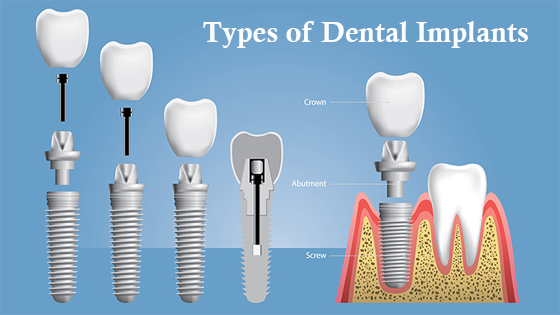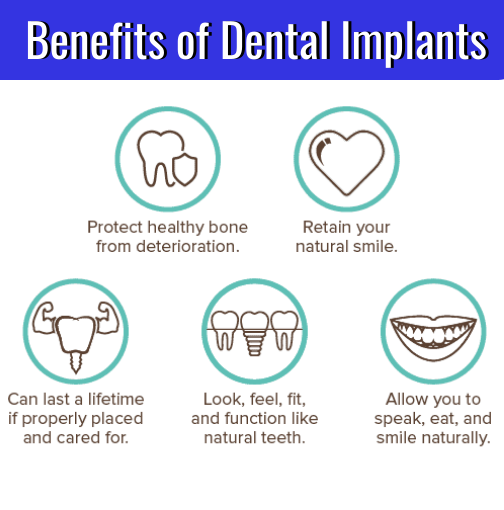Dental Implants
Tooth replacement services have largely improved over the past few decades. Today, dental implants are used by many people. They are mostly used by people who have lost their teeth or tooth due to an injury, periodontal disease, or any other reasons.

What Are Dental Implants?
Dental implants refer to the replacement of teeth. They are metal frames or posts that are surgically placed in the jawbone underneath the gums. When they are positioned, the dentist can easily mount the replaced teeth on them.
A dental implant refers to replacing missing teeth in a way that it achieves fixed and permanent results. Dental implants act as artificial teeth roots that are placed in the jaw to hold replaced teeth or bridges. Although, dental implants are not designed in a way that can replace the missing tooth structure, they can be inserted into healthy jawbones by experienced and qualified dentists like us. These titanium posts perfectly replace the missing teeth root.
How do Dental Implants Work?
Dental implants provide stable support to artificial teeth by blending into the jawbone. The bridges and dentures that are mounted to implants cannot shift or slip in the mouth, which is a great advantage when the person having dental implants speaks or eats.
The secure fit of dental implants helps the bridges as well as the dentures, along with individual crowns that are placed on top of the implants. This feels far more natural as compared to conventional dentures or bridges.
For some people, regular dentures and bridges are very uncomfortable. Such people are even scared to get them, owing to sore spots, gagging, or poor ridges. Moreover, standard bridges are attached to the teeth into any side of the space left by the absent tooth.
One of the advantages of dental implants is that they do not require any adjacent teeth to ground down or prepare to hold the new replacement teeth or tooth in place. However, the person who desires to have dental implants should have adequate bone and healthy gums in order to provide optimal support to the dental implant. Plus, these structures should be kept healthy by regular dental visits and maintaining scrupulous oral hygiene, so that the dental implants can be successful for a long-term.
Types of Dental Implants

There are two types of dental implants that are considered to be safe by dentists. These include:
1. Subperiosteal implants (on the bone)
These types of dental implants are placed over the jaw. They comprise of metal frames that are fitted onto the jawbone just underneath the gum tissue. This frame becomes permanent to the jawbone with the healing of the gums.
The posts that are fastened to the frame stick out through the gums in order to hold the prosthesis. Then, artificial teeth are positioned on the posts. Subperiosteal implants are generally used for patients who have small bone height or who are not able to wear traditional dentures.
2. Endosteal implants (in the bone)
The other safe type of dental implants that are more commonly used is Endosteal implants. They are available in various types, including blades, cylinders, and screws. These dental implant types are surgically and directly fixed into the jawbone. Each of this dental implant holds one or more prosthetic teeth.
Then, a second surgery is connected in order to attach the post to the first dental implant after the healing of the nearby gum tissue. Finally, artificial teeth or tooth is fixed to the post separately or is grouped on a denture or bridge, just like subperiosteal implants. Endosteal implants are typically used as a substitute for patients with removable dentures or bridges.
How Are Dental Implants Placed?
Although, dentists can use many other methods to place dental implants, generally they are positioned in the following ways.
1. First, a dental implant is positioned inside the hole that is there in the bone.
2. Then, a hole is made in the bone.
3. After this, the dental implant is positioned inside the bone hole.
4. The cut is then closed through a stitch.
5. After the gum heals, a new cut is made on top of the dental implant. Then a healing cap, which is a piece of metal, is generally positioned over the dental implant in order to direct the healing tissue. Later, this healing cap is removed. Then, an abutment, which is a permanent part, is attached on the dental implant for the crown support.
6. Finally, the crown that looks like a natural tooth is cemented and attached on the abutment.
Advantages of Dental Implants

There are a lot of advantages of dental implants in the modern world. With the progression of dental materials and techniques, the feel as well as the look of dentures has improved drastically. However, it is only dental implants that can replace the absent teeth roots.
Dental implants are capable of closely mimicking the overall structure and form of natural teeth. They look completely natural, so much that even the patients that have got dental implants forget that they have artificial teeth in their mouth. Moreover, the bridges and dentures that are mounted to implants cannot shift or slip in the mouth, which helps the person with dental implants while they speak or eat.
Dental implants replace the missing teeth with crowns, full denture appliances, or a bridge. The aesthetics and functionality of dental implants are restored so much that they look completely original. Plus, dental implants offer a very secure and stable fit. They do not even require any adjacent teeth to ground down or prepare to hold the new replacement teeth or tooth in place.
Cost of Dental Implant Treatment

Dental implants are generally more expensive than other tooth replacement methods. Moreover, most of the insurance providers usually cover less than 10% of the total fees of dental implants. The cost of dental implant treatments vary according to the number of absent teeth that require dental implants.
The price also depends on the nature of the case of individual patients, as some patients may need additional procedures to deal with loss of bone before dental implants are placed in their mouth. When you visit the dentist, you can consult about the cost of dental implant you may require, depending on your needs and preferences.